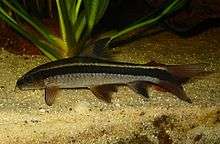Flying fox (fish)
The flying fox (Epalzeorhynchos kalopterus) is a Southeast Asian species of freshwater fish in the family Cyprinidae.[2] It is commonly kept in the aquarium trade. Among other foods, it is known to eat green algae.[2][3][4] It is sometimes mistakenly referred to as the Siamese algae eater.[5]
| Flying fox | |
|---|---|
 | |
| Scientific classification | |
| Kingdom: | Animalia |
| Phylum: | Chordata |
| Class: | Actinopterygii |
| Order: | Cypriniformes |
| Family: | Cyprinidae |
| Genus: | Epalzeorhynchos |
| Species: | E. kalopterus |
| Binomial name | |
| Epalzeorhynchos kalopterus (Bleeker, 1850) | |
| Synonyms | |
|
Barbus kalopterus Bleeker, 1850 | |
Description
The flying fox fish has a characteristic long body with a flat abdominal area. Its dorsal area has a coloration ranging from olive to dark brown. The lower half of its body has a yellowish white hue. A brownish-black line runs from its mouth to the caudal fin. On top of this distinctive black line is a gold-colored stripe. The eyes of a flying fox may have a reddish iris. Its dorsal, anal and ventral fins consist of a transparent front with a thick black band along the edge.[2][3]
Although capable of reaching up to 6 inches (15.24 cm), flying foxes have an average length of 4.7 inches (11.94 cm) and are frequent victims of stunting in the aquarium setting.[2][3]
Distribution and habitat
The flying fox is a bottom-dweller that is native to the fast-flowing foothill rivers and streams of the Thai-Malay Peninsula, Borneo, Java and Sumatra in Southeast Asia.[2][3]
In the aquarium

Tank requirements
A 40 gallon breeder tank or larger lined with fine gravel or sand substrate is suitable for an average-sized flying fox fish. Being bottom-dwellers, the aquarium for flying foxes usually has broad-leaved plants, rocks, and driftwood to serve as hiding places. Because the flying fox is a known algae-eater, adequate lighting is preferred. Flying foxes can survive in aquarium water that has a pH of 6 to 7.5, a water hardness ranging from 2 to 12 dH, and temperatures kept at 23 to 27 °C (73 to 81 °F).[3][4]
Behavior
Being a peaceful fish when kept singly, flying foxes are generally compatible with acaras, angelfish, barbs, danios, eartheaters, gouramis, knifefish, loaches, tetras and rasboras. Aquarists may keep these fish alone or in schools, however a group of flying foxes may exhibit territorial behavior.
Diet
Although algae eaters, flying foxes are also known to accept food in the form of flakes, wafers and tablets. Being omnivorous, vegetables such as spinach, zucchini and lettuce, as well as live planarians, tubifex worms, crustaceans and other aquatic insects are excellent staples for a flying fox. Oatmeal is sometimes accepted as well. They do not consume red algae.[2][3][4]
Similar species
The flying fox is similar to the Siamese algae eater (Crossocheilus oblongus) and the false flying fox (Garra cambodgiensis) when young.[5]
References
Specific
- Ahmad, A.B. & Ho, J.K.I. 2019. Epalzeorhynchos kalopterus. The IUCN Red List of Threatened Species 2019: e.T181151A91002676. Downloaded on 24 July 2019.
- Froese, Rainer and Pauly, Daniel, eds. (2014). "Epalzeorhynchos kalopterus" in FishBase. April 2014 version.
- Flying Fox (Epalzeorhynchus kallopterus), Mongabay.com, 2006, retrieved on: August 20, 2007
- Flying Fox (Epalzeorhynchos kalopterus), AquariumLife.net (undated), retrieved on: August 20, 2007
- Flying Fox Information, The Aquarium Wiki Encyclopaedia, retrieved on: March 1st, 2008
- Dunder, Jonathan. Free Information Society, FreeInfoSociety.com (undated), retrieved on: August 20, 2007
General
- Epalzeorhynchos kalopterus (Bleeker, 1851), Taxonomic Serial No.: 639590, ITIS.gov, 2007, retrieved on: August 21, 2007
- Epalzeorhynchos kalopterus on the Aquarium Wiki Encyclopaedia
